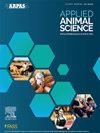Evaluation of the use of beef semen on dairy operations: A survey of Idaho dairies
IF 1.5
Q3 AGRICULTURE, DAIRY & ANIMAL SCIENCE
引用次数: 0
Abstract
Objective
The aim of this study was to survey current Idaho dairies on their use of beef semen and gain insights into the criteria and decisions made on farm.
Materials and Methods
A mail-in survey was sent to all registered Idaho dairies (n = 369). The survey consisted of 40 questions consisting of multiple choice, ranking, and open answer styles. The survey was mailed on August 8, 2022, with a reminder postcard sent on October 8, 2022, to dairies that had not returned the initial survey. The survey was mailed a second time on November 5, 2022, to all the dairies that had not responded to the initial survey. Responses were categorized by dairy herd size and region within Idaho.
Results and Discussion
We had a total response rate of 14.1%; of the dairies that responded, 78.8% breed a portion of their herd to beef semen. The use of beef semen was significantly affected by dairy herds size. “Failure to conceive” was ranked most important when deciding which cows were bred to beef, followed by “milk production.” Black Angus was the most chosen breed of a sire, followed by Charolais. Dairies ranked the “breeding service picks the bulls” as most important when selecting beef sires, followed by “calving ease” and “semen cost.” Only 26.8% of dairies raise their own beef × dairy calves, and 69.4% sell the beef × dairy calves as day-old calves. The economic benefit of breeding to beef was evident, with the average price for beef × Holstein, beef × Jersey, and beef × Holstein × Jersey being 3.14×, 1.36×, and 4× that for pure dairy, respectively.
Implications and Applications
These results add knowledge regarding the on-farm decision when breeding dairy cattle to beef sires. This will help guide future research in beef × dairy animals by keeping on-farm decisions in mind.
牛肉精液在奶制品生产中的应用评价:爱达荷州奶制品的调查
目的本研究的目的是调查目前爱达荷州奶牛场对牛肉精液的使用情况,并深入了解农场的标准和决策。材料与方法向所有注册的爱达荷州奶牛场(n = 369)邮寄调查问卷。该调查由40个问题组成,包括多项选择,排名和开放式回答方式。该调查于2022年8月8日寄出,并于2022年10月8日向未退还初始调查的奶牛场发送提醒明信片。该调查于2022年11月5日第二次邮寄给所有没有回应第一次调查的乳制品公司。回应按奶牛群规模和爱达荷州的地区分类。结果与讨论总有效率为14.1%;在接受调查的奶牛场中,78.8%的奶牛场用牛肉精液喂养了一部分奶牛。牛精液的利用受奶牛群规模的显著影响。在决定哪些奶牛被培育成牛肉时,“怀孕失败”被列为最重要的因素,其次是“产奶量”。黑安格斯是最受欢迎的品种,其次是夏洛莱。奶牛场在选择牛肉品种时最看重的是“繁育服务挑选公牛”,其次是“产犊难易程度”和“精液成本”。只有26.8%的奶牛场自己饲养牛乳小牛,69.4%的奶牛场将牛乳小牛作为日龄小牛出售。养殖对牛肉的经济效益明显,牛×荷斯坦、牛×泽西、牛×荷斯坦×泽西的均价分别是纯乳均价的3.14倍、1.36倍和4倍。启示和应用这些结果增加了关于将奶牛培育成肉牛的农场决策的知识。这将有助于通过牢记农场决策来指导未来对牛肉和奶牛的研究。
本文章由计算机程序翻译,如有差异,请以英文原文为准。
求助全文
约1分钟内获得全文
求助全文

 求助内容:
求助内容: 应助结果提醒方式:
应助结果提醒方式:


